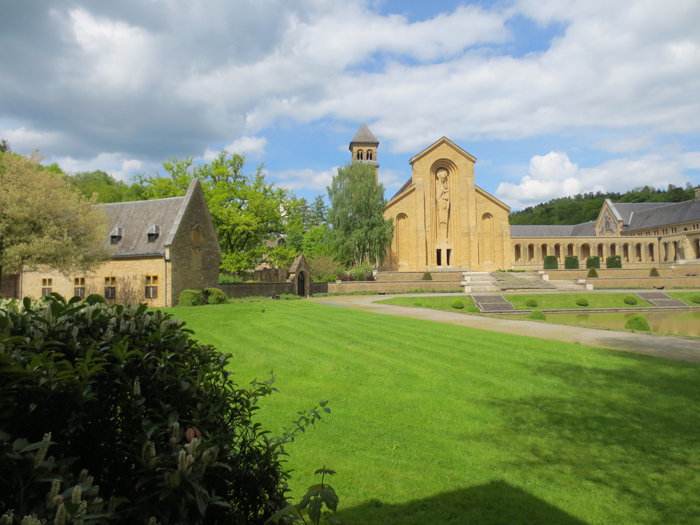Belgium’s Orval Brewery is one of just a handful of Trappist Breweries in the world. The monastery is a must visit for beer enthusiasts who appreciate this divine brew.
What’s a Trappist brewery? In 1997, eight Trappist abbeys – six from Belgium (Orval, Chimay, Westvleteren, Rochefort, Westmalle and Achel), one from the Netherlands (Koningshoeven) and one from Germany (Mariawald) – founded the International Trappist Association (ITA) to prevent non-Trappist commercial companies from abusing the Trappist name. This private association created a logo that is assigned to goods (cheese, beer, wine, etc.) that respect precise production criteria.
 Trappist logo – Courtesy of ITA
Trappist logo – Courtesy of ITA
For beers to qualify as Trappist made, the basic criteria are:
- The beer must be brewed within the walls of a Trappist monastery, either by the monks themselves or under their supervision. The phrase “under their supervision” is key. For example, as noted by Orval Brewery, their “monks have never been directly involved in the production of beer…four brethren (monks) with the Abbot as president are actually well involved in the Board of Orval brewery, with three independent members involved in all decisions. A brother is present every day in the business.”
- The brewery must be of secondary importance within the monastery and it should witness to the business practices proper to a monastic way of life.
- The brewery is not intended to be a profit-making venture. The income covers the living expenses of the monks and the maintenance of the buildings and grounds. Whatever remains is donated to charity for social work and to help persons in need.
- Trappist breweries are constantly monitored to assure the irreproachable quality of their beers.
The ITA has a legal standing, and its logo gives the consumer some information and guarantees about the product.
Orval Abbey is in the southeast corner of Belgium near the border to France. One of the reasons my wife and I always wanted to visit Orval was because they have incredibly beautiful grounds and old Abbey ruins that tourists can visit for a modest fee. Tourists cannot visit the modern Abbey grounds used by the monks of today but can get a peek. Orval Abbey also has a gift shop where you can buy beer, cheese, postcards, and many other gift items. Orval Brewery is not open to visitors, except during an annual event which lasts only two days.
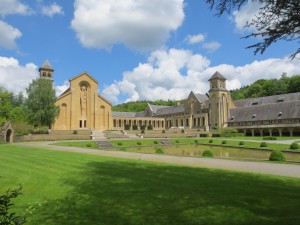 Modern Orval Abbey Monastery Grounds (monks only!)
Modern Orval Abbey Monastery Grounds (monks only!)
We visited Orval Abbey in 2013 and were enthralled. As the two of us walked the open grounds and Abbey ruins at Orval, we were quickly immersed in tranquility. The ruins were from buildings that dated as far back as the 1100’s and yet the site was alive with beautiful ornate architecture that still spoke of the monks’ spiritual devotion and the activities of their daily lives.
Of course, I also wanted to visit because of Orval’s unique, delicious beer. As noted by Orval, “Throughout the long history of Orval, there has probably always been a brewery at the monastery. Various facts corroborate this idea : topographical references on old drawings; a detailed description of production left by a Franciscan visitor three hundred years ago; an area called the “hop-field” very close to the monastery. To brew beer was customary in these areas little-suited to vine-growing. Beer was first and foremost considered for its nourishing properties : it was called “liquid bread”.”
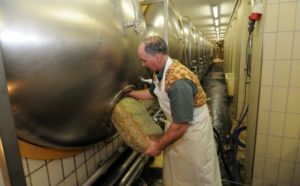 Orval Brewery – Photograph courtesy of Orval Brewery
Orval Brewery – Photograph courtesy of Orval Brewery
Located within the confines of the Abbey, Orval’s production brewery started operations in 1931. The brewery was needed to generate funds to support the construction of a new and expanded Abbey. The first master brewer at Orval was a German by the name of Mr. Pappenheimer. The origins of Orval’s very distinctive beer can probably be attributed jointly to Mr. Pappenheimer and to the Belgians, Honoré Van Zande and John Vanhuele, who were working in the brewery at the same period. Today, Mrs. Anne-Françoise Pypaert, Brewing Engineer, has taken over the duties of Brewmaster for Orval Brewery .
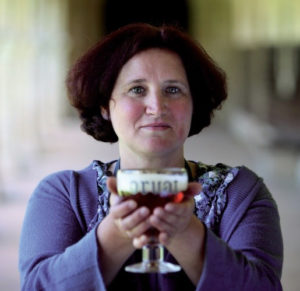 Mrs. Anne-Françoise Pypaert is Brewmaster for Orval – Photograph courtesy of InkyBeer.com
Mrs. Anne-Françoise Pypaert is Brewmaster for Orval – Photograph courtesy of InkyBeer.com
Orval Brewery only makes two beers – one for sales and one for the monks’ consumption. The beer that Orval sells (known as Orval Trappist Ale) is actually a higher alcohol version (6.2% ABV) of the beer that has traditionally been consumed by Orval monks (commonly known as Petit Orval or ‘green’ Orval and with an ABV of 3.5-4.2%) .
Orval Trappist Ale is a Belgian Pale Ale and is readily found in the United States. Orval also makes some delicious cheeses. There is a café, called A l’Ange Gardien (The Guardian Angel), just outside the abbey where you can eat lunch while enjoying Orval beer. This cafe is also the only location where you can get Petit Orval (served on tap).
Here is Orval’s description of how their beer is made:
The RAW MATERIALS for Orval beer are spring water, two-row malting spring barley, aromatic hops and liquid candy sugar.
BREWING: After grinding and what is known as “infusion” brewing and filtering, the wort is sent to the wort boiler where it is boiled for one and a half hours; it is then that the hops are added. The wort is then cooled.
FERMENTATION: Specific Orval “top fermentation” yeasts are microscopic fungi that turn sugar into alcohol and carbon dioxide. The first fermentation in conical-cylindrical tanks takes four to five days at a temperature of 15 to 23°C.
STORAGE: A second strain of yeast is added to continue the fermentation. Bags containing hop cones are macerated in the beer for two to three weeks to improve the aromas of the beer – a process known as dry hopping.
RACKING: After centrifugation, new yeast and sugar are added to trigger re-fermentation in bottles, and the beer is then stored. Orval Brewery produces only one bottled beer. Optimum quality is ensured through continuous inspections.
FERMENTATION IN BOTTLES: Once stored, the beer will continue to ferment slowly in maturing cellars for three to five weeks at a constant temperature of 15°C. The temperature at which the beer will be enjoyed will depend on this re-fermentation temperature. The skittle-shaped bottle was designed specially to delight the eye of the consumer with a superb beer, by retaining the yeast sediment when the beer is served. This sediment is teeming with vitamin B, and can be drunk afterwards.
Orval Trappist Ale has a beautiful amber-orange color with a slight haze and a magnificent white head. The aroma is of flowers and lemony citrus. The beer is crisp and clean on the palate and flavors of lemon and hay abound. There is a wonderful tartness and hop bitterness and the beer finishes exquisitely dry. Drink this beer on a warm summer day while eating some soft cheese on rye crackers and reflect on the simple glory of brewing beer.
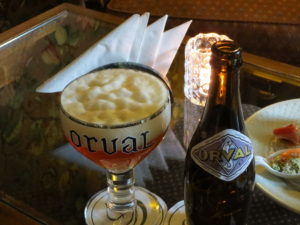 Orval Brewery Creates Trappist Vitality in a Glass
Orval Brewery Creates Trappist Vitality in a Glass
